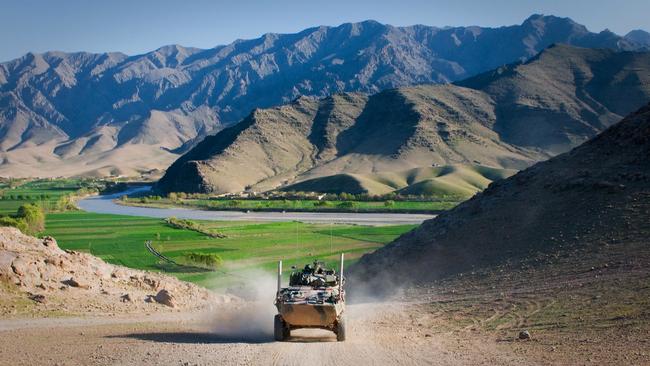Hard lessons from Afghanistan campaign
For the ADF, working alongside American and British forces in Afghanistan laid the groundwork of trust from which AUKUS could emerge.

The Australian Defence Force of 2021 is a substantially more robust, honed, networked and interoperable force than it was in 2001.
But looking back over two decades the Afghanistan legacy is mixed at best. The ADF remains a boutique force in size and scope, designed for the post-Cold war unipolar moment when the defence of Australia required little and alliance commitments could be met with niche contributions from the force in being.
That is now changing, but the experience of working alongside American and British forces laid the groundwork of trust from which AUKUS could emerge.
The 9-11 attacks led then prime minister John Howard to invoke the ANZUS Treaty’s mutual defence clause, which in turn triggered what turned out to be a two decade-long force commitment to Afghanistan. That would see a range of troop rotations including a Special Forces Task Group (2001-2002), then in 2005 a returned Special Operations Task Group on three four-month rotations, this time based in Uruzgan province, in the middle of the country. This 12-month commitment would eventually span a decade.
The SOTG prepared the ground for an engineer-led reconstruction task force which was then focused on winning hearts and minds in a traditional counterinsurgency (COIN) campaign. But COIN is tricky, messy and devilishly hard to pull off, with few successes to note in history beyond the British experience in the Malayan Emergency of the 1950s.
In Malaya, geography proved advantageous, notably a peninsula with only a small land border at one end. Strategy also helped. Armed with a sensible way forward, the plan offered a viable alternative to peaceful and equitable governance. Control over the government also helped to ensure the plan was deliverable.

The combined effect was to give the British, with Australians in support, a distinct and unique advantage. COIN as it was practised in Afghanistan lacked the key advantages the British had wielded effectively half a century earlier and so was arguably doomed from the outset.
Informed by its own operational experience in Malaya, as well as in Vietnam’s Phuoc Tuy province (where localised successes were notable), Australians went into Afghanistan with some hope. But the faults soon became apparent.
The ADF approached the campaign in Uruzgan with 12-24 month horizons, avoiding looking too deeply and over too long a time span at the prospects of success.
Without being prepared to contribute more resources, with a porous border through which refreshed Taliban fighters could flow (from Pakistan), and without a national strategy for accountable governance inside Afghanistan, success was well-nigh impossible to achieve. It was made all the more difficult by the governance arrangements established by the Loya Jirga in 2002, whereby chieftains drawing on central government allocations were the principal financial beneficiaries. Unchecked power and corruption went hand-in-hand.
Facing limited success at best on the ground, over time the reconstruction task force morphed into a mentoring and reconstruction task force and then a mentoring task force. The special forces continued facing relentless challenge against an enemy unconstrained by the rules of war. Their response was overwhelmingly professional but the disturbing exceptions left a deep scar, reinforcing how messy COIN can be.
The legacy of that remains unresolved in the Australian military consciousness to this day.
Overall, perhaps we were a bit too clever by half. The Australian contribution was politically calibrated but when it came to stepping up to the plate to command the force in Uruzgan following the Dutch withdrawal, Australia ducked and weaved, leaving American counterparts disappointed and unimpressed with the cynical approach taken.
By 2014 combat forces were withdrawn, along with those of most coalition partners. The residual training and advisory commitment to Afghanistan from 2014 to 2021 was provisional and dependent on US staying power. Many look back and wonder what the point was.
Australia had gone along in the first instance to counter the threat of terrorism and support the United States, expecting the American leadership to develop a strategy for success.
The driving pillars, alliance management and countering terrorism, motivated successive Australian commitments. When operational and tactical priorities strayed, a discordance emerged between those deployed in Uruzgan, the joint task force headquarters (JTF633) in the Middle East, and back in Canberra.
Along the way, as Karen Middleton observed in An Unwinnable War, journalists were kept on a short leash, lest the strategic-operational dissonance become too obvious to the Australian public.
Notwithstanding the evident limitations of the campaign, and the cost in lives lost (averaging about two per year over the 20 years) Australia came to see its contribution having ongoing merit. Particularly with embedded appointments in positions across the command and support headquarters and institutions, the ADF gained much experience and fostered greater networking, particularly with US (and UK) counterparts.
The Royal Australian Navy gained considerable experience working alongside US Navy and Royal Navy ships in the Persian Gulf and the experience helped justify the upgrade of the Anzac frigates, as well as the acquisition of Air Warfare Destroyers, along with heightened interoperability.
The air force also gained from the experience and its commitments helped justify and demonstrate the utility of capabilities missing from its inventory: Airborne Early Warning and Control (AEW&C) aircraft, a fleet of modern refuellers, latest generation P8 Poseidon surveillance aircraft, C-17 long-range and heavy-lift cargo aircraft, Growler airborne electronic attack aircraft, two squadrons of Super Hornets and a fleet of F35 Joint Strike Fighters. Cumulatively, this represented a transformation of the RAAF into a “fifth generation” air force.
Today the ADF looks impressive and gained immeasurably from the Afghanistan experience. But it remains limited in size and scope, designed, essentially for a time when US economic and military dominance was largely unchallenged. The world is a different place today.
-
John Blaxland is co-editor of Niche Wars: Australia in Afghanistan and Iraq, 2001-2014 (ANU Press, 2020)
